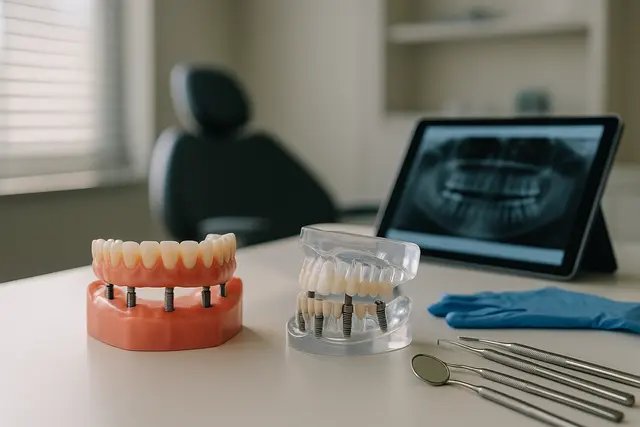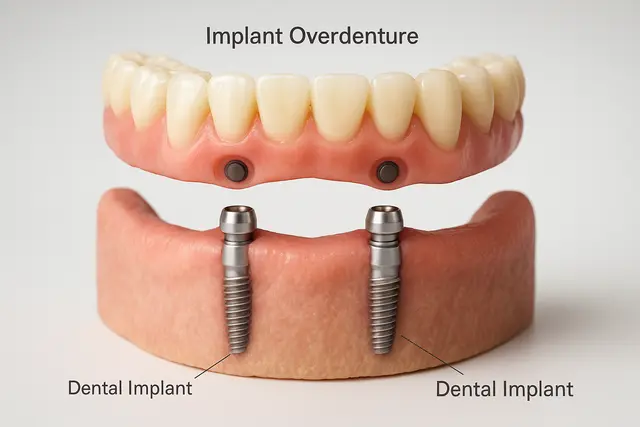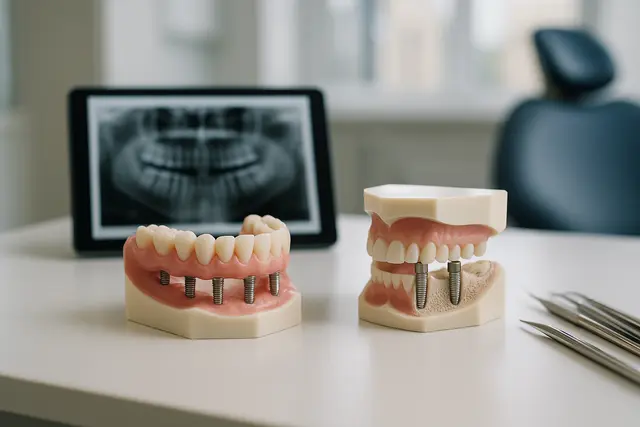Prosthodontics
8 min read
Mar 28, 2025
Single Tooth Implant vs. 3-Unit Bridge
Tooth loss can lead to functional and aesthetic problems. Two common solutions for replacing a single missing tooth are a dental implant or a 3-unit bridge. Each option restores chewing ability and appearance, but they differ in how they work, how long they last, and what impact they have on your oral health.

Dental Implant Overview
A friendly confession before we dig in: nobody daydreams about dental work while sipping morning coffee. But if you’ve lost one tooth (or fear you soon might), questions about the best tooth replacement option can keep you up at night. Should you go with a single implant or a three‑unit bridge?
Which feels more like your old tooth, which is kinder to your wallet, and which wins the longevity race? Below you’ll find a straight‑shooting, slightly humorous, deeply practical guide that compares a single tooth implant to a 3‑unit dental bridge. Grab a comfy chair, and let’s talk shop.
Picture a tiny titanium screw that stands in for a missing tooth root, that’s the implant post. Implant dentistry has come a long way since the first experimental fixtures in the 1960s. Today, dental implants are small threaded marvels the American Dental Association praises for strength and biocompatibility. Once the implant is placed in your jaw, bone cells hug it like a long‑lost cousin.
After healing, a custom dental crown attaches to the top of the implant and handles the biting, chewing, and selfie‑smiling you did with your natural teeth.
Dentists call this “restoring a single tooth without borrowing parts from its neighbors.” Because the implant stands alone, tooth structure must be removed from zero surrounding teeth. That preservation of sound teeth adjacent to the gap is one of the big advantages of dental implants. If you’re the type who hates collateral damage, you’ll like that.
Candidates for Dental Implants
A quick checklist: healthy gums, enough bone, decent overall dental care habits, and a willingness to wait a few months while the implant takes. Implant procedures span three basic phases, implant placement, osseointegration, and dental crown delivery.
Some folks worry the timeline sounds long, but keep in mind that implants and bridges both require lab work. An implant is an excellent long‑term investment because dental implants last decades when you brush, floss, and show up for cleanings.
Dental Bridge Overview
Now picture a tiny rowboat made of porcelain and metal: two anchor points (crowns) and the false tooth (pontic) in between. That’s a dental bridge. A three‑unit bridge consists of crowns on the abutment teeth with a floating unit in the middle. Traditional dental bridge therapy has helped patients chew steaks and twirl spaghetti since your grandfather’s day. Dental bridges replace the visible part of the missing tooth quickly, often in two visits.
Types of Dental Bridges
The common type of dental bridge is, well, the traditional bridge just described. Two interesting cousins deserve a shout‑out: the resin‑bonded bridge (better known as a Maryland bridge) and the cantilever bridge. A resin‑bonded bridge skips full crowns and uses thin wings bonded behind the adjacent teeth. A cantilever bridge uses only one abutment; think of it as a porch swing bolted to a single post. Bridge nerds love these variations because each solves a different clinical puzzle.
Abutment Teeth and Adjacent Teeth
Here’s where bridges reveal their Achilles’ heel. To create room for the bridge, a dentist shapes (some would say sacrifices) the teeth on either side of the gap. Those abutment teeth must lose healthy enamel so crowns fit snugly.
If the teeth adjacent to the missing tooth are pristine, this can feel like carving a window into a brand‑new wall just to hang curtains. Disadvantages of placing a bridge include nerve irritation, future root‑canal risk, and the fact that dental bridges require flawless daily floss threading beneath a bridge to keep decay away.
Missing Teeth and Tooth Replacement
Whether you lost one tooth to a rogue popcorn kernel or tooth decay stage‑dove into your molar, missing teeth play dirty tricks: they let neighboring teeth drift, poke holes in your confidence, and even change speech. Both options, dental implants and bridges, aim to replace missing teeth, close that gap, and stop the domino effect. The best tooth replacement is the one you can afford, maintain, and trust for the long haul.
Crown and Dental Prosthesis
Every solution ends in a crown. On an implant, the crown screws or cements onto the abutment attached to the implant post. On a bridge, crowns fuse to the false tooth as a single dental prosthesis held in place by dental cement. Either way, the crown’s porcelain surface is what your tongue and Instagram followers will see. Pro tip: ask your dental laboratory to match shade and translucency so your new tooth doesn’t look like it’s auditioning for a disco.
Implant-Supported and Implant-Supported Bridge
Most folks weighing one missing tooth stick with a single‑tooth implant rather than an implant‑supported bridge, but it’s nice to know the latter exists. An implant‑supported bridge spreads forces across two implants and skips grinding any natural teeth. That option really shines when you’re missing three or more teeth in a row. For one tooth, a lone implant‑supported crown usually wins.
Bridge vs Implant: Choosing a Replacement Option
Time for the head‑to‑head fun, bridge vs implant. A traditional bridge could be ready in weeks and often costs less upfront. A single implant demands surgery and patience but usually delivers better dental biomechanics and bone health. Dental implants may stimulate jawbone, preventing the slow melt of bone beneath a bridge. Bridge vs implant is a decision shaped by budget, timeline, bone quality, and frankly, your tolerance for floss threaders.
Advantages of Dental Implants (and a Few Cons)
Advantages of dental implants include bone preservation, freedom for surrounding teeth, and longevity that sometimes outlives the family dog (sorry, Sparky). Cons of dental implants? Upfront cost, healing time, and the small, yet real, risk of implant failure. Early implant failure usually links to infection, smoking, or uncontrolled diabetes. Late failure might involve overload or bone loss around the implant. Thankfully, careful implant treatment planning slashes those odds.
Teeth Around a Bridge
Bridge critics note that teeth around a bridge carry extra stress. If clenching, grinding, or large fillings weaken those pillars, the whole bridge might wobble someday. Dentists try to spread the load, but physics stays stubborn. People with parafunctional habits should chat about an occlusal guard to protect both bridge and an implant on the other side, if you have one.
Placement of Implants and Implant Procedures
Implant placement is usually quicker than folks expect, often under an hour for one site. Local anesthetic, a pilot drill, a few twists, and the implant is placed.
After a short rest, you walk out with a tiny cover screw at the top of the implant and bragging rights for surviving “surgery” during lunchtime. The placement of implants can coincide with extraction if infection is low and bone is sufficient. That combo visit lets the implant needs merge with fresh socket walls, allowing the implant to integrate faster.
Dental Insurance, Cost of Dental, and Better Dental Financing
Here’s the not‑so‑fun part. Dental insurance plans rarely shower you with unlimited implant benefits. Some policies classify implants as elective, while others cover part of the crown but not the fixture. Bridges often enjoy broader coverage because insurance actuaries still consider them “standard of care.”
Yet the cost of dental implants has dropped over the years as technology improves, and many offices offer financing. A payment plan can spread fees over months, making the replacement option you want the replacement option you can actually start.
Natural Teeth, Surrounding Teeth, Teeth Adjacent, and Better Dental Health
Whichever road you choose, never forget the real MVPs, your natural teeth. The goal is to protect every tooth around the treatment zone. Brush twice, use dental floss nightly, and schedule cleanings so that surrounding teeth stay healthy. That way, a single implant stays single, and a bridge doesn’t need more neighbors joining the pontic party.
Common Questions Lightning Round
Will a bridge in place feel bulky? Some patients say it feels slightly wider than one tooth, but most adjust within days.
Does getting a dental implant hurt? Nerves are numbed, you feel pressure, not pain. Post‑op soreness fades with mild meds.
What about implant vs bridge longevity? Dental implants last 20‑30 years or more; a bridge could serve a solid decade before replacement.
Are there candidates for dental implants who still choose a bridge? Yes. Smokers, patients on bisphosphonates, or those seeking faster results often pick bridges.
Are options are dental bridges alone? Nope. Partial dentures, resin‑bonded bridge designs, and, yes, leaving a gap, exist, but each carries trade‑offs.
Bridge Could or Implant Should?
A bridge could save you time and upfront cash, especially when the adjacent teeth already need crowns. An implant should rise to the top of the list when the teeth adjacent to the missing space are pristine and you value bone preservation. Both routes involve skilled dentists, a trustworthy dental laboratory, and your daily commitment to hygiene.
Around the Implant and Beneath a Bridge: Maintenance Tips
Food packs differently around the implant collar than beneath a bridge. Interdental brushes glide around the implant, whereas super‑floss sneaks beneath a bridge. Ignore either zone, and plaque will issue late‑night eviction notices to your gums. Take five extra seconds to clean those areas, and both restorations age gracefully.
Pro Tips on Fixed Dental Upkeep
Use a low‑abrasive toothpaste; whitening grit can scratch porcelain.
Ask your hygienist to show how to loop floss around the implant post.
Schedule X‑rays at recommended intervals to spot early decay under bridge wings.
Report any looseness immediately, early intervention averts dental implant failure or bridge collapse.
Bridge and an Implant in One Mouth
Plenty of people sport a bridge on the left and a single implant on the right. Implants and bridges can coexist peacefully when bite forces are balanced. Your dentist may suggest a night guard if you grind, protecting both the bridge consists of crowns and the implant‑supported crown.
Fixed vs Removable: Why We Didn’t Talk Dentures
Removable partials solve some gaps, but most patients hunting for confidence prefer fixed dental solutions. A fixed dental restoration lets you bite into a crisp apple without worrying the prosthesis will stay behind in the fruit.
Disadvantages of Placing a Bridge (Summary)
Requires preparing abutment teeth
Dental bridges are generally harder to floss
Risk of decay beneath retainers
Bridge might need replacement sooner than you’d like
Advantages (and a Few Cons) of Dental Implants (Summary)
Allows the implant to stimulate bone
No impact on teeth around a bridge site
Implant post feels like a natural tooth root
Higher cost and surgical steps mean patience required
Final Thoughts Before You Book That Consult
You’ve just surfed through roughly two thousand words on a topic most dinner guests avoid. Give yourself a pat on the back, and maybe schedule a check‑up. Getting a dental implant or getting a dental bridge isn’t a decision to make alone, so lean on your dentist’s diagnostic eye, your wallet’s comfort zone, and a realistic look at hygiene habits. The solution for replacing missing teeth that fits your life will keep you smiling, chewing, and telling corny jokes for years.
Because when one tooth goes AWOL, you deserve a comeback story that ends with confident grins, not endless Googling.
What Is the Difference Between a Single Tooth Implant and a Dental Bridge?
A single tooth implant replaces a missing tooth with a titanium post and crown without affecting neighboring teeth, while a dental bridge uses crowns on adjacent teeth to support a false tooth. Implants preserve jawbone and keep nearby teeth untouched, whereas bridges may require shaving down healthy enamel on surrounding teeth.
Which Option Lasts Longer: A Dental Implant or a Bridge?
Dental implants typically last 20–30 years or more with proper care, while bridges usually last about 10–15 years. Implants tend to offer better long-term value, especially since they help preserve bone and require less maintenance of nearby teeth.
Is a Dental Bridge Better If I Want a Faster or Cheaper Fix?
Yes, a traditional bridge is often quicker to place and less expensive upfront. It may be ideal if the adjacent teeth already need crowns or if you're looking for a non-surgical solution. However, it may require more maintenance over time and doesn’t protect the jawbone like an implant does.
How Do I Choose Between a Bridge and an Implant?
Your choice depends on several factors: the health of adjacent teeth, jawbone density, personal budget, timeline, and oral hygiene habits. If your neighboring teeth are healthy and you want to preserve bone, an implant is usually the better choice. If speed and cost are priorities, a bridge might make more sense. A consultation with your dentist can help weigh both options clearly.Ask ChatGPT
Read Next
Related Posts

Prosthodontics
Implant Supported Dentures Overview
Missing teeth can impact more than just your smile, they can affect your confidence, comfort, and even your diet. Fortunately, modern dentistry offers a solution that’s both secure and natural-looking: implant-supported dentures. This innovative approach blends the stability of implants with the convenience of dentures to create a long-lasting, life-improving upgrade.
5 min read
Oct 29, 2025

Prosthodontics
Implant Overdentures Explained: The Hybrid Solution to Missing Teeth
Missing teeth can impact everything from your ability to eat to your self-confidence. While traditional dentures have long been a go-to solution, they often fall short in comfort and stability. Implant overdentures offer a modern alternative that combines the security of dental implants with the convenience of removable dentures, a true upgrade for those looking to reclaim their smile.
6 min read
Oct 29, 2025

Prosthodontics
Implant Retained Dentures Explained
Considering implant-retained dentures? You're not alone. As modern dentistry evolves, more people are turning to this secure, natural-feeling alternative to traditional dentures. This guide will walk you through what they are, how they work, and why they might be the solution you've been looking for.
4 min read
Oct 28, 2025
Don’t have time to research every dentist around you?
See why 30k+ patients trusted us